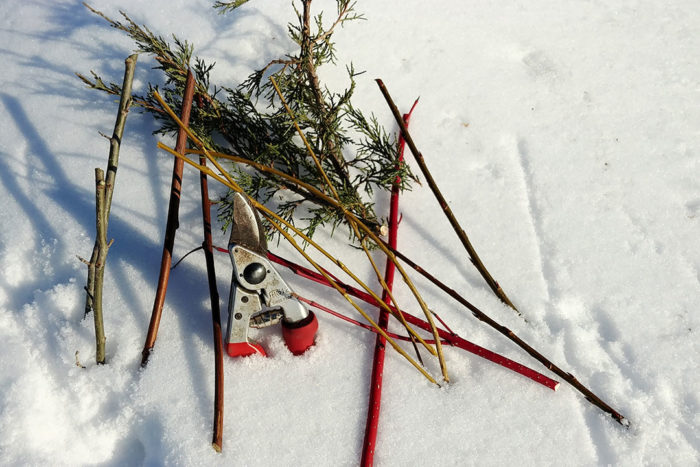
In the heart of winter, gardening tasks can be somewhat few and far between; however, there are some tasks that can be accomplished during this otherwise dormant time of year. One of these is propagating native shrubs and trees through hardwood cuttings.
Hardwood cuttings are typically taken from older stems that are harvested during the dormant season. Shrubs such as redtwig dogwood (Cornus sericea, Zones 3–8), trees such as cottonwood (Populus deltoides, Zones 2–9), and evergreens such as Rocky Mountain juniper (Juniperus scopulorum, Zones 3–7) can by propagated with high success using this method. While every propagator prefers a different method, the basics are the same. Cuttings are usually taken from two-year-old wood and cut to a length of 6 inches or longer, with the terminal growing tip removed. This newer growth from within the past year needs to be removed because it has very little stored carbohydrates and will starve the plant when buds break in the spring before it can establish roots. These cuttings may then be treated with a rooting hormone on the cut end and placed in a growing medium.

One of the easiest genera to propagate via hardwood cuttings is willow (Salix spp. and cvs., Zones 2–10). There are about 110 species of willow native to North America, with many of those native to the Northern Plains. Most have a limited value to the landscape due to their brittle wood and need for consistent maintenance and care; however, peachleaf willow (Salix amygdaloides, Zones 4–8) and pussy willow (Salix discolor, Zones 4–8) are attractive native trees and shrubs to consider propagating by simply taking a branch and sticking it in the ground, as they root quite readily. This can be done as long as the ground isn’t frozen. You shouldn’t have to worry about watering it as it establishes itself in the spring, when ground moisture is usually abundant. In unusually dry springs, you will want to add supplemental water as needed to maintain a moist substrate until established. Ninebark (Physocarpus opulifolius, Zones 2–8) is another appealing native shrub widely used in the landscape that can be propagated via hardwood cuttings. Another great choice is the underutilized golden currant (Ribes aureum, Zones 4–8).

Rooting hormones can increase the success rate of any cutting, sometimes by leaps and bounds depending on the genus. There are gels, liquids, and powders of various strengths that can be used with the same basic mechanics of dipping or coating the base of the cutting and inserting it into your growing medium. Your growing medium will depend on your genus. As mentioned earlier, willows will root easily by simply placing them in the ground, whereas ninebark prefer a sand-peat-perlite blend in a 6:4:3 ratio to facilitate high rooting success. Keeping adequate moisture available is also important for the cuttings to become established, especially if propagating indoors. Too much moisture in the soil will promote rot, while too little will dry out the cutting, so keep a close eye on the media while the cuttings root out.

With a little trial and error, you can find what works best for you, so grab your pruners and find an excuse to do a little midwinter gardening.
—Chris Schlenker is the head gardener of McCrory Gardens at South Dakota State University in Brookings, South Dakota.


















Comments
Log in or create an account to post a comment.
Sign up Log in